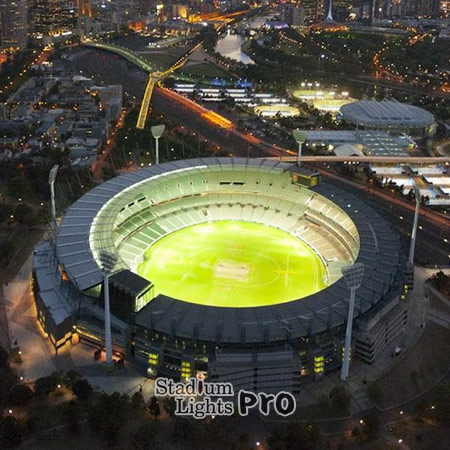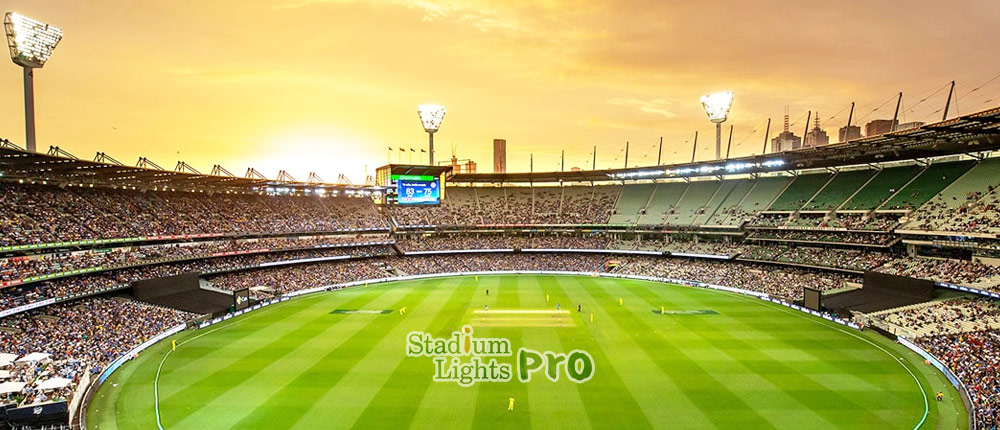Cricket is a sport that has captured the hearts of millions around the world. It is played both during the day and under floodlights in stadiums equipped with a suitable lighting system. The quality of lighting in a cricket stadium is crucial for players, officials, and spectators alike, as it ensures clear visibility and optimal playing conditions. We would explore the factors involved in determining the number of light poles needed in a cricket stadium.
Table of Contents
ToggleHow many light poles are there in cricket field and stadium?
The number of light poles in a cricket stadium can vary depending on several factors, including the size and layout of the stadium, the lighting requirements, and the specific lighting design chosen. While there is no fixed rule regarding the exact number of light poles, stadiums typically employ either 4, 6, or 8 poles to illuminate the playing area effectively. Let’s explore each option in more detail:
Four light poles
Using four light poles is a common approach in smaller cricket stadiums or those with limited space. The poles are strategically positioned at each corner of the playing area to provide sufficient illumination across the field. This configuration can ensure a uniform distribution of light, minimizing shadows and providing acceptable lighting conditions for players and spectators. However, it is worth noting that larger stadiums or those with complex layouts may require additional light poles to achieve the desired lighting levels throughout the playing area.
Six light poles
 Many medium-sized cricket stadiums opt for a six-pole lighting configuration. In this setup, two supplementary light poles are placed along the sides of the playing area in addition to the four corner poles. The extra poles enhance the lighting coverage, particularly towards the middle of the field. This configuration helps to reduce the possibility of shadows and improves visibility for players in critical areas of the ground, such as the batting crease, the pitch, and the fielding positions. Six light poles offer a balanced and effective lighting solution for a wide range of cricket stadiums.
Many medium-sized cricket stadiums opt for a six-pole lighting configuration. In this setup, two supplementary light poles are placed along the sides of the playing area in addition to the four corner poles. The extra poles enhance the lighting coverage, particularly towards the middle of the field. This configuration helps to reduce the possibility of shadows and improves visibility for players in critical areas of the ground, such as the batting crease, the pitch, and the fielding positions. Six light poles offer a balanced and effective lighting solution for a wide range of cricket stadiums.
Eight light poles
Larger cricket stadiums, particularly those hosting international matches or high-profile tournaments, often employ an eight-pole lighting arrangement. This configuration involves adding two more light poles along the longer sides of the field, complementing the four corner poles and the two side poles of the six-pole setup. With eight poles, the lighting coverage is further optimized, ensuring consistent illumination across the entire playing area. The increased number of poles helps to eliminate any potential dark spots or shadows, offering enhanced visibility and meeting the stringent lighting requirements for professional cricket matches.
The precise number of light poles required for a specific cricket stadium depends on various factors, and a professional lighting design analysis is typically conducted to determine the optimal configuration. This analysis considers the unique characteristics and requirements of the stadium to ensure optimal visibility and an enjoyable experience for players and spectators.
How to determine the optimal number of light poles in a cricket stadium?
Cricket stadium size and layout

The size and layout of the cricket stadium play a significant role in determining the number of light poles required. Larger stadiums with extensive playing areas may require more poles to ensure even distribution of light across the field. Besides, the shape and dimensions of the playing area, such as the distance from the boundary to the pitch and the presence of any obstructions, need to be considered.
Lux level requirements
The lux level refers to the amount of illumination required on the playing surface. The International Cricket Council (ICC) guidelines state that a minimum lux level of 1500 is necessary for international matches, while domestic games may have lower requirements. The lux level takes into account factors such as the speed of the ball and the distance between the batsman and the fielder. Calculating the required lux level helps determine the number and arrangement of light poles.
LED lighting for cricket field
Advancements in lighting technology have significantly improved the efficiency of lighting systems. Traditional lighting options, such as metal halide lamps, have been largely replaced by more energy-efficient options like LED (Light Emitting Diode) lights. LED lights offer better light output, longer lifespan, and reduced energy consumption. When considering the number of light poles, the choice of lighting technology can impact the overall lighting requirements.
Light distribution and shadowing
An even distribution of light across the field is crucial to avoid shadows and ensure consistent visibility for players. Shadows on the playing surface can affect the judgment of fielders, making it essential to position the light poles strategically. Factors such as the height and angle of the light poles, the distance between them, and the direction of light distribution all play a role in minimizing shadows and optimizing visibility.
Calculating the number of light poles in cricket stadium
Determining the precise number of light poles in a cricket stadium involves a comprehensive lighting design analysis. This analysis takes into account the factors mentioned above, along with other technical specifications specific to the lighting system. Specialized lighting engineers or consultants are typically employed to carry out this analysis, using computer simulations and lighting software.
The lighting design analysis considers factors such as the required lux level, the mounting height of the light poles, the beam angle of the lights, and the type of lighting technology being used. By carefully analyzing these variables, the engineers can calculate the number of light poles needed and their optimal placement to achieve uniform lighting throughout the stadium.
Conclusion
The number of light poles required in a cricket stadium depends on various factors, including the stadium size, lux level requirements, lighting technology, and the need for even light distribution. A comprehensive lighting design analysis is crucial to determine the precise number and placement of light poles in order to provide optimal visibility for players and spectators alike.
Investing in an efficient lighting system not only enhances the overall cricketing experience but also contributes to player safety and performance. As technology continues to advance, the future may bring further improvements in lighting solutions, making cricket stadiums even more immersive and enjoyable for fans worldwide.
Are you in need of expert guidance for lighting design and pole layout consultation for your cricket field? Look no further! Contact us today to avail yourself of our complimentary services. Our team of lighting professionals will provide you with a comprehensive lighting design analysis tailored to your specific requirements. With our expertise, we can help determine the ideal number and placement of light poles to ensure optimal visibility and an immersive experience for players and spectators alike. Don’t miss out on this opportunity – reach out to us now to benefit from our free lighting design consultation for your cricket stadium!

